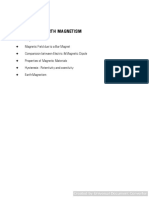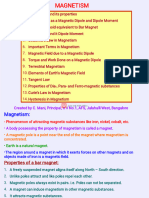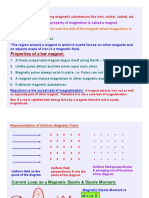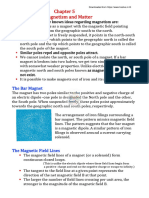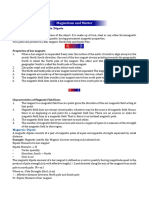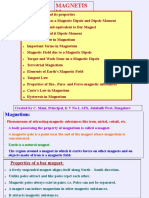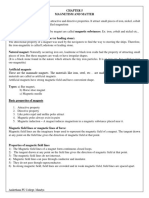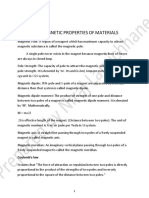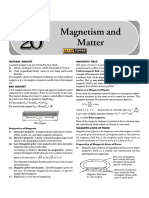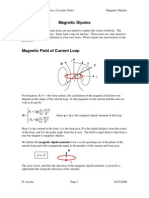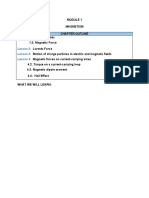Basic properties of magnets
Basic properties of magnets
Uploaded by
abnnersandhu181207Copyright:
Available Formats
Basic properties of magnets
Basic properties of magnets
Uploaded by
abnnersandhu181207Copyright
Available Formats
Share this document
Did you find this document useful?
Is this content inappropriate?
Copyright:
Available Formats
Basic properties of magnets
Basic properties of magnets
Uploaded by
abnnersandhu181207Copyright:
Available Formats
MAGNETISM AND MATTER (momentum science institute)
Basic properties of magnets :
1. Attractive property.
2. Directive property.
3. Like poles repel and unlike poles attract.
4. Magnetic poles always exist in pairs.
5. Magnetic induction.
6.Repulsion is the surer test of magnetism.
Some important definitions connected with magnetism :
1. Magnetic field. The space around a magnet within which its influence can be
experienced is called its magnetic field.
2. Uniform magnetic field. A magnetic field in a region is said to be uniform if it has same
magnitude and direction at all points of that region.
3. Magnetic poles. These are the regions of apparently concentrated magnetic strength in a
magnet where the magnetic attraction is maximum. The poles of a magnet lie somewhat
inside the magnet and not at its geometrical ends.
4. Magnetic axis. The line passing through the poles of a magnet is called the magnetic axis
of the magnet.
5. Magnetic equator. The line passing through the centre of the magnet and at right angles
to the magnetic axis is called the magnetic equator of the magnet.
6. Magnetic length. The distance between the two poles of a magnet is called the magnetic
length of the magnet. It is slightly less than the geometrical length of the magnet.
Magnetic length
It is found that Geometrical length = 0.84
Coulomb's law of magnetic force. This law states that the force of attraction or repulsion
between two magnetic poles is directly proportional to the product of their pole strengths and
inversely proportional to the square of the distance between them.
μ0 q m1 q m2
.F= .
4π r2
An arrangement of two equal and opposite magnetic poles separated by a small
distance is called a magnetic dipole. Every bar magnet is a magnetic dipole. A current
carrying loop behaves as a magnetic dipole. Even an atom acts as a magnetic dipole due to
the circulatory motion of the electrons around its nucleus.
Magnetic dipole moment. The magnetic dipole moment of a magnetic dipole is defined as
the product of its pole strength and magnetic length. It is a vector quantity, directed from S-
1
pole to N-pole.
Page
ANANT KUMAR , VIKAS PURI . NEW DELHI-18, M-9810305798 , 8882488790
MAGNETISM AND MATTER (momentum science institute)
⃗⃗⃗ = qm × l
m
A magnetic line of force may be defined as the curve the tangent to which at any point
gives the direction of the magnetic field at that point. It may also be defined as the path
along which a unit north pole would tend to move if free to do so.
Properties of lines of force :
1. Magnetic lines of force are closed curves which start in air from the N-pole and end at the
S-pole and then return to the N-pole through the interior of the magnet.
2. The lines of force never cross each other. If they do so, that would mean there are two
directions of the magnetic field at the point of intersection, which is impossible.
3. They start from and end on the surface of the magnet normally.
4. The lines of force have a tendency to contract lengthwise and expand sidewise. This
explains attraction between unlike poles and repulsion between like poles.
5. The relative closeness of the lines of for magnet measure of the strength of the magnetic
field which is maximum at the poles.
Magnetic field of a bar magnet at an axial point (end-on position). Let NS be a bar
magnet of length 21 and of pole strength q m. Suppose the magnetic field is to be determined
at a point P which lies on the axis of the magnet at a distance r from its centre, as shown in
Fig. 5.13.
Fig. 5.13 Magnetic field of a bar magnet at an axial point.
Imagine a unit north pole placed at point P. Then from Coulomb's law of magnetic forces, the
force exerted by the N-pole of strength qm on unit north pole will be
μ qm
FN = 4π0 . (r−𝑙) ⃗⃗⃗⃗⃗⃗
2 , along NP
Similarly, the force exerted by S‐ pole on unit north pole is
μ qm
FS = 4π0 . (r+𝑙) ⃗⃗⃗⃗⃗
2 , along PS
⃗⃗ at point P is
Therefore, the strength of the magnetic field B
Baxial = Force experienced by a unit north‐ pole at point P
μ0 q𝑚 1 1
= FN − FS = [ 2
− ]
4π (r − l) (r + l)2
μ 0 qm 4rl
= . 2
4π (r2 − l )2
But qm . 2l = m, is the magnetic dipole moment, so
μ0 2mr
Baxial = . 2
4π (r2 − l )2
2
For a short bar magnet, l << 𝑟, therefore, we have
Page
ANANT KUMAR , VIKAS PURI . NEW DELHI-18, M-9810305798 , 8882488790
MAGNETISM AND MATTER (momentum science institute)
μ 2m
Baxial = 4π0 . r3
, along ⃗⃗⃗⃗⃗⃗
NP …(1)
Clearly, the magnetic field at any axial point of magnetic dipole is in the same direction as
that of its magnetic dipole moment i.e., from S‐ pole to N‐ pole, so we can write
μ0 2m
⃗⃗⃗
⃗ axial =
B . 3
4π r
Magnetic field of a bar magnet at an equatorial point (broadside-on position).
Consider a bar magnet NS of length 2l and of pole strength qm. Suppose the magnetic field
is to be determined at a point Plying on the equatorial line of the magnet NS at a distance r
from its centre, as shown in Fig. 5.14.
Fig. 5.14 Magnetic field of a bar magnet at an equatorial point.
Imagine a unit north-pole placed at point P. Then from Coulomb's law of magnetic forces,
the force exerted by the N-pole of the magnet on unit north-pole is
μ qm
FN = 4π0 . x2
, along NP
Similarly, the force exerted by the S‐ pole of the magnet on unit north‐ pole is
μ q𝑚
F𝑆 = 4π0 . x2
, along PS
As the magnitudes of FN and FS are equal, so their vertical components get cancelled while
the horizontal components add up along PR.
Hence the magnetic field at the equatorial point P is
Bequa = Net force on a unit N-pole placed at point P
= FN COS θ + FS COS θ
= 2 FN cos θ [∵ FN = FS]
μ q 𝑙 l
= 2. 4π0 . 𝑥m2 . x [∵ cos θ = 𝑥 ]
μ m
or Bequa = 4π0 . [∵ x = (r2 + l2 )1⁄2 ]
(𝑟2 +l2 )3⁄2
where m = qm . 2l, is the magnetic dipole moment.
Again for a short magnet, l << r, so we have
μ m
𝐵equa = 4π0 . r3 , along PR …(2)
3
Clearly, the magnetic field at any equatorial point of a magnetic dipole is in the direction
Page
opposite to that of its magnetic dipole moment i.e., from N‐ pole to S‐ pole. So we can write
ANANT KUMAR , VIKAS PURI . NEW DELHI-18, M-9810305798 , 8882488790
MAGNETISM AND MATTER (momentum science institute)
μ0 m
⃗⃗⃗
⃗Bequa = −
4πr3
Torque on a magnetic dipole in a uniform magnetic
field. Consider a bar magnet NS of length 2l placed in a uniform magnetic field ⃗B. Let qm be
the pole strength of its each pole. Let the magnetic axis of the bar magnet make an angle θ
with the field ⃗B, as shown in Fig. 5.21(a).
Force on N-pole = qm B; along ⃗B
⃗
Force on S-pole = qm B, opposite to B
Fig. 5.21 (a) Torque on a bar magnet in a magnetic field.
⃗⃗⃗⃗ , ⃗B.
(b) Relation between the directions of τ⃗, m
The forces on the two poles are equal and opposite. They form a couple. Moment of couple
or torque is given by
τ = Force × perpendicular distance
= qm B × 2l sin θ = (qm × 2l) B sin θ
or τ = mB sin θ ...(1)
where m = qm × 2l, is the magnetic dipole moment of the bar magnet. In vector notation,
⃗⃗⃗ × ⃗B ...(2)
τ⃗⃗ = m
The direction of the torque τ⃗⃗ is given by the right hand screw rule as indicated in Fig.
⃗.
5.21(b). The effect of the torque τ⃗⃗ is to make the magnet align itself parallel to the field B
That is why a freely suspended magnet aligns itself in the north-south direction because the
earth has its own magnetic field which exerts a torque on the magnet tending it to align along
the field.
Special Cases
1. When the magnet lies along the direction of the magnetic field,
θ = 0°, sin θ = 0, τ = 0,
Thus the torque is minimum.
2. When the magnet lies perpendicular to the direction of the field,
θ = 90°, sinθ = 1, τ = mB
Thus the torque is maximum.
τmax = mB
Potential energy of a magnetic dipole. when a magnetic dipole is placed in a uniform
⃗ at angle θ with it, it experiences a torque
4
magnetic field B
Page
τ = mB sin θ
ANANT KUMAR , VIKAS PURI . NEW DELHI-18, M-9810305798 , 8882488790
MAGNETISM AND MATTER (momentum science institute)
This torque tends to align the dipole in the direction of ⃗B.
If the dipole is rotated against the action of this torque, work has to be done. This work is
stored as potential energy of the dipole.
The work done in turning the dipole through a small angle dθ is
dW = τ dθ = mB sin θ dθ
If the dipole is rotated from an initial position θ = θ1 to the final position θ = θ 2, then the total
work done will be
𝜃 θ
W = ∫ d W = ∫𝜃 2 m B sin θ d θ = mB[− cos θ]θ21
1
= - mB (cos θ2 - cos θ1)
This work done is stored as the potential energy Id of the dipole.
∴ U = - mB (cos θ2 - cos θ1)
The potential energy of the dipole is zero when m ⃗ . So potential energy of the dipole in
⃗⃗⃗ ⊥ B
any orientation θ can be obtained by putting θ 1 = 90° and θ2 = θ in the above equation.
∴ U = - mB (cos θ - cos 90°)
or U = - mB cos θ = - m ⃗
⃗⃗⃗ . B
Special Cases
1. When θ = 0°, U =- mB cos 0° = - mB
Thus the potential energy of a dipole is minimum when m is parallel to B. In this state, the
magnetic dipole is in stable equilibrium.
2. When θ = 90°, U = - mB cos 90° = 0.
3. When θ = 180°, U = - mB cos 180° = + mB.
Thus the potential energy of a dipole is maximum when m is antiparallel to ⃗B. In this state,
the magnetic dipole is in unstable equilibrium.
Analogy between electric and magnetic dipoles
Physical quantity Electrostatics Magnetism
Free space constant 1 μ0
ε0
Dipole moment p
⃗ ⃗⃗
m
Axial field 1 2p ⃗ μ0 2m
⃗⃗⃗
. 3 . 3
4πε0 r 4π r
Equatorial field 1 ⃗p μ0 m
⃗⃗⃗
− . − . 3
4πε0 r3
5
4π r
Page
ANANT KUMAR , VIKAS PURI . NEW DELHI-18, M-9810305798 , 8882488790
MAGNETISM AND MATTER (momentum science institute)
Torque in external field ⃗p × ⃗⃗E ⃗
⃗⃗⃗ × B
m
P.E. in external field ⃗⃗
⃗ .E
−p ⃗⃗
⃗⃗⃗ . B
−m
Magnetic dipole moment of a revolving electron. According to Bohr model of
hydrogen-like atoms, negatively charged electron revolves around the positively charged
nucleus. This uniform circular motion of the electron is equivalent to a current loop which
possesses a magnetic dipole moment = IA As shown in Fig. 5.23, consider an electron
revolving anticlockwise around a nucleus in an orbit of radius r with speed v and time period
T.
Equivalent current,
Charge e e ev
I= = = =
Time T 2πr⁄v 2πr
Area of the current loop, A = πr2
Therefore, the orbital magnetic moment (magnetic moment due to orbital motion) of the
electron is
ev
μl = IA = . πr 2
2πr
evr
or μl = 2
…(1)
As the negatively charged electron is revolving anticlockwise, the associated current flows
clockwise.
Also, the angular momentum of the electron due to its orbital motion is
l = me vr …(2)
Dividing equation (1) by (2), we get
μl evr⁄2 e
= =
l me vr 2m𝑒
The above ratio is a constant called gyromagnetic ratio. Its value is 8.8 × 1010 Ckg−1 . So
e
μl = l
2me
Vectorially,
e
μl = −
⃗⃗⃗ 𝑙
2me
6
μl . According to Bohr’s
The negative sign shows that the direction of l is opposite to that of ⃗⃗⃗
Page
quantisation condition, the angular momentum of an electron in any permissible orbit is
ANANT KUMAR , VIKAS PURI . NEW DELHI-18, M-9810305798 , 8882488790
MAGNETISM AND MATTER (momentum science institute)
integral multiple of h/2π, where h is Planck’s constant, i.e.,
nh
l = 2π, where n = 1, 2, 3, …
eh
∴ μl = n (4πm )
e
This equation gives orbital magnetic moment of an electron revolving in n th orbit.
Bohr magneton. It is defined as ihe magnetic moment associated with an electron due to its
orbital motion in the first orbit of hydrogen atom. It is the minimum value of μl which can be
obtained by putting n = 1 in the above equation. Thus Bohr magneton is given by
eh
μB = (μl )min =
4πme
Putting the values of various constants, we get
−19 −34
1.6 × 10 C × 6.63 × 10 Js
μB = −31
4 × 3.14 × 9.11 × 10 kg
= 9.27 × 10−24 0
1. Geographic axis. The straight line passing through the geographical north and south
poles of the earth is called its geographic axis. It is the axis of rotation of the earth.
2. Magnetic axis. The straight line passing through the magnetic north and south poles of
the earth is called its magnetic axis.
The magnetic axis of the earth makes an angle of nearly 20° with the geographic axis. At
present, the magnetic south pole S m is located at a point in Northern Canada at a latitude of
70.5°N and a longitude of 96°W. The magnetic north pole N is located diametrically opposite
to Sm i.e., at a latitude of 70.5°S and a longitude of 84°E. The magnetic poles are nearly
2000 km away from the geographic poles. The magnetic equator intersects the geographic
equator at longitudes of 6°W and 174°E.
3. Magnetic equator. It is the great circle on the earth perpendicular to the magnetic axis.
4. Magnetic meridian. The vertical plane passing through the magnetic axis of a freely
suspended small magnet is called magnetic meridian. The earth's magnetic field acts in the
direction of the magnetic meridian.
5. Geographic meridian. The vertical plane passing through the geographic north and
south poles is called geographic meridian.
7
Page
ANANT KUMAR , VIKAS PURI . NEW DELHI-18, M-9810305798 , 8882488790
MAGNETISM AND MATTER (momentum science institute)
ELEMENTS OF EARTH'S MAGNETIC FIELD
23. What are the elements of earth's magnetic field ? Explain their meanings. Show these
elements in a labelled diagram and deduce various relations between them.
Elements of earth's magnetic field. The earth's magnetic field at a place can be completely
described by three parameters which are called elements of earth's magnetic field. They are
declination, dip and horizontal component of earth's magnetic field.
1. Magnetic declination. The angle between the geographical meridian and the magnetic
meridian at a place is called the magnetic declination (α) at that place.
Magnetic declination arises because the magnetic axis of the earth does not coincide with its
geographic axis.
2. Angle of dip or magnetic inclination. The angle made by the earth's total magnetic field
⃗B with the horizontal direction in the magnetic meridian is called angle of dip (δ) at any place.
8
Page
ANANT KUMAR , VIKAS PURI . NEW DELHI-18, M-9810305798 , 8882488790
MAGNETISM AND MATTER (momentum science institute)
The angle of dip is different at different places on the surface of the earth. Consider a dip
needle, which is just another compass needle but pivoted horizontally so that it is free to
rotate in a vertical plane coinciding with the magnetic meridian. It orients itself so that its N-
pole finally points exactly in the direction of the earth's total magnetic field ⃗B. The angle
between the horizontal and the final direction of the dip needle gives the angle of dip at the
given location.
At the magnetic equator, the dip needle rests horizontally so that the angle of dip is zero at
the magnetic equator. The dip needle rests vertically at the magnetic poles so that the angle
of dip is 90° at the magnetic poles. At all other places, the dip angle lies between 0° and 90°.
3. Horizontal component of earth's magnetic field. It is the component of the earth's total
magnetic field ⃗B in the horizontal direction in the magnetic meridian. If δ is the angle of dip at
any place, then the horizontal component of earth's field B⃗ at that place is given by
BH = B cos δ
At the magnetic equator, δ = 0°, BH = B cos 0° = B
At the magnetic poles, δ = 90°, BH = B cos 90° = 0
Thus the value of BH is different at different places on the surface of the earth.
Fig. 5.32 Elements of earth's magnetic field.
Relations between elements of earth's magnetic field. Fig. 5.32 shows the three elements of
earth's magnetic field. If δ is the angle of dip at any place, then the horizontal and vertical
components of earth's magnetic field B ⃗ at that place will be
9
BH = B cos δ ...(1)
Page
and BV = B sin δ
ANANT KUMAR , VIKAS PURI . NEW DELHI-18, M-9810305798 , 8882488790
MAGNETISM AND MATTER (momentum science institute)
B Bsin δ
∴ B V = B cos δ
H
B
or BV = tan δ …(2)
H
Also
B2H + B2V = B2 (cos2 δ + sin2 δ) = B2
or B= √B2𝐻 + B2V …(3)
Equations (1), (2) and (3) are the different relations between the elements of earth's
magnetic field. By knowing the three elements, we can determine the magnitude and
direction of the earth's magnetic field at any place.
Neutral point. It is the point where the magnetic field due to a magnet is equal and
opposite to the horizontal component of earth's magnetic field. The resultant magnetic field
at the neutral point is zero. If a compass needle is placed at such a point, it can stay in any
position.
(i) Magnet placed in the magnetic meridian with its north pole pointing north. Fig. 5.34 shows
the magnetic lines of force of a bar magnet placed in the magnetic meridian with its north-
pole pointing towards the geographic north of the earth. The fields due to the magnet and
the earth are in same directions at points on the axial line and are in opposite directions at
points on the equatorial line. So the resultant field is stronger at axial points and weaker at
equatorial points. The two neutral points P and Q lie on the equatorial line.
Let
r = distance of each neutral point from the centre of the magnet
2l = length of the magnet
m = dipole moment of the magnet
Fig. 5.34 Field lines of a bar magnet with its N-pole towards north.
Then megnetic field strength at each neutral point is
μ m
Bequa = 0 .
4π (r + l2 )3⁄2
2
For a short magnet, l < < r, therefore,
µ m
Bequa = 0 . 3
10
4π r
Page
At the neutral point, the field of the magnet is balanced by the horizontal component B H of
the earth's magnetic field so that
ANANT KUMAR , VIKAS PURI . NEW DELHI-18, M-9810305798 , 8882488790
MAGNETISM AND MATTER (momentum science institute)
µ0 m
BH = .
4π r3
Knowing rand BH, the value of the magnetic dipole moment m can be determined.
(ii) Magnet placed in the magnetic meridian with its south-pole pointing north. Fig. 5.35
shows the magnetic lines of force of a bar magnet placed in the magnetic meridian with its
south-pole pointing towards the geographic north of the earth. Here the fields due to the
magnet and the earth are in the same direction at points on the equatorial line and are in
opposite directions at points on the axial line of the magnet. So the resultant field is weaker
at axial points and is stronger at equatorial points. In this case the two neutral points P and
Q lie on the axial line near the ends of the magnet.
Fig. 5.35 Field lines of a bar magnet with S-pole towards north.
Suppose r be the distance of each neutral point from the centre of the magnet. Let 2l be the
length of the magnet. Then magnitude of the magnetic field at either of the neutral points will
be
µ 2mr
Baxial = 0 . 2 2 3
4π (r − l )
For a short magnet, l << r, therefore
µ m
Baxial = 0 . 3
4π r
Again, at the neutral point, the field of the magnet is balanced by the horizontal component
BH of the earth's magnetic field, so we have
µ m
BH = 0 . 3
4π r
Knowing the values of r and B H, the magnetic dipole moment m of the magnet can be
determined.
SOME IMPORTANT TERMS USED TO DESCRIBE MAGNETIC PROPERTIES OF
MATERIALS
1. Magnetising field. When a magnetic material is placed in a magnetic field, a magnetism
is induced in it. The magnetic field that exists in vacuum and induces magnetism is called
magnetising field. For example, consider a toroidal solenoid carrying current I and placed in
vacuum. If the solenoid has n turns per unit length, then the magnetic field set up in the
solenoid is given by
11
B0 = μ0nI
This field is called the magnetising field caused by the so called free current in the solenoid.
Page
2. Magnetic induction., suppose the toroidal solenoid is wound round a ring of magnetic
ANANT KUMAR , VIKAS PURI . NEW DELHI-18, M-9810305798 , 8882488790
MAGNETISM AND MATTER (momentum science institute)
material. Under the influence of field B Q, the
the material which is given by
BM = µ0 nIM
The total magnetic field inside a magnetic material is the sum of the external
magnetizing field and the additional magnetic field produced due to magnetization of
the material and is called magnetic induction 𝐁 ⃗⃗ . The magnetic induction may also be
defined as the total number of magnetic lines of force crossing per unit area normally
through a material. Thus the SI unit of magnetic induction is tesla (T) or weber metre -2 (Wbm-
2
) which is equivalent to NM-1A-1 or JA-1m-2.
3. Magnetising field intensity. The ability of magnetising field to magnetise a material
medium is expressed by a vector ⃗𝐇 ⃗ , called magnetising field intensity or magnetic
intensity. Its magnitude may be defined as the number of ampere-turns (nI) flowing round
the unit length of the solenoid required to produce the given magnetising field. Thus
H = nI
B0
∴ B0 = μ0nI = μ0H or H =
µ0
The dimensions of magnetic intensity are [L-1 A]. Its SI unit is ampere metre -1 (Am-1) which is
equivalent to Nm-2T-1 or Jm-1Wb-1.
4. Intensity of magnetisation. When a magnetic material is placed in a magnetising field, it
gets magnetised. The magnetic moment developed per unit volume of a material when
placed in a magnetising field is called intensity of magnetisation or simply magnetisation.
⃗⃗⃗ = m
M
⃗⃗⃗
V
If IM is the surface magnetisation current set up in a solenoid of cross-sectional area A and
having n turns per unit length, then magnetic moment developed per unit length of the
solenoid is nIM A. Therefore, magnetic moment developed per unit volume or the
magnetisation M ⃗⃗⃗ is given by
m nIM A
M= = = nIM
V A
Hence BM = μ0 nIM = μ0 M
Again, consider a bar of magnetic material having cross‐ sectional area a and length 2l. Its
volume is
V = a × 2𝑙
Suppose the bar develops pole strength qm when placed in a magnetising field, then its
magnetic moment,
m = qm × 2𝑙
m qm ×2l qm
∴𝑀 = V
= a×2l
= a
Hence intensity of magnetisation may also be defined as the pole strength developed per
unit cross‐ sectional area of a material.
As the total magnetic field or the magnetic induction 𝐵 ⃗ inside a magnetic material is the
12
⃗⃗ M produced due to the magnetisation of
⃗ 0 and the field B
resultant of the magnetising field 𝐵
the material, therefore,
Page
B = B0 + B𝑀 = μ 0 H + μ 0 M
ANANT KUMAR , VIKAS PURI . NEW DELHI-18, M-9810305798 , 8882488790
MAGNETISM AND MATTER (momentum science institute)
or B = µ0 (H + M)
Clearly, both H and M have the same units, namely Am-1.
5. Magnetic Permeability. Permeability is the measure of the extent to which a material can
be penetrated magnetic field. The magnetic permeability of a material may be defined as
the ratio of its magnetic induction B to the magnetic intensity H.
B
μ=H
Clearly, SI unit of μ
tesla
=
ampere metre−1
= tesla metre ampere-1 or TmA-1
∴ Dimensions of μ = [MLT-2A-2].
6. Relative permeability. Permeability of various magnetic substances can be compared with
one another in terms of relative permeability μ r. It is defined as the ratio of the permeability of
the medium to the permeability of free space. Thus,
µ
μr = µ
0
For vacuum μr =1, for air it is 1.0000004 and for iron, the value of μ r may exceed 1000.
7. Magnetic susceptibility. Magnetic susceptibility measures the ability of a substance to take
up magnetisation when placed in a magnetic field. It is defined as the ratio of the intensity of
magnetisation M to the magnetising field intensity H. It is denoted by χm. Thus,
M
χm = H
As magnetic susceptibility is the ratio of two quantities having the same units (Am-1), so it
has no units.
8. Relation between magnetic permeability and magnetic susceptibility. If a linear magnetic
material, subjected to the action of a magnetising field intensity H, develops magnetisation M
and magnetic induction B; then
B = μ0 (H + M)
But B = μ H
∴ μ H = μ0(H + M)
M
or μ = μ0(1 + ) or μ = μ0(1 + χm)
H
or μ0μr = μ0(1 + χm) or μr = 1 + χm.
Comparative study of the properties of dia-, para- and ferromagnetic substances
Property Diamagnetic Paramagnetic Ferromagnetic
substances substances substances
1. Effect of They are feebly They are feebly They are strongly
magnets repelled by magnets. attracted by magnets. attracted by magnets.
2. In external Acquire feeble Acquire feeble Acquire strong
13
magnetic field magnetisation in the magnetisation in the magnetisation in the
opposite direction of direction of the direction of the
Page
the magnetising field. magnetising field. magnetising field.
ANANT KUMAR , VIKAS PURI . NEW DELHI-18, M-9810305798 , 8882488790
MAGNETISM AND MATTER (momentum science institute)
3. In a non- Tend to move slowly Tend to move slowly Tend to move quickly
uniform from stronger to from weaker to stronger from weaker to stronger
magnetic field weaker parts of the parts of the field. parts of the field.
field.
4. In a uniform A freely suspended A freely suspended A freely suspended
magnetic field diamagnetic rod aligns paramagnetic rod ferromagnetic rod aligns
itself perpendicular to aligns itself parallel to itself parallel to the field.
the field. the field.
5. Susceptibility Susceptibility is small Susceptibility is small Susceptibility is very
value (χm) and negative. - 1 ≤ χm < and positive. 0 < χm < ε, large and positive. χm >
0 where ε is a small 1000
number
6. Relative Slightly less than 1 Slightly greater than 1 1 Of the order of
permeability < μr < 1 + ε thousands μr >1000
0≤ μr < 1
value (μr)
7. Permeability μ <μ0 μ > µ0 μ >> μ0
value (μ)
8. Effect of Susceptibility is Susceptibility varies Susceptibility decreases
temperature independent of inversely as with temperature in a
temperature. temperature : complex manner.
1 1
χm ∝ . χm ∝ T − T (T > TC)
T C
9. Removal of Magnetisation lasts as As soon as the Magnetisation is
magnetising long as the magnetising field is retained even after the
field magnetising field is removed, magneti- magnetising field is
applied. sation is lost. removed.
10. Variation of M M changes linearly with M changes linearly with M changes with H non-
with H H. H and attains saturation linearly and ultimately
at low temperature and attains saturation.
in very strong fields.
11. Hysteresis B-vector shows no B-vector shows no B-vector shows
effect hysteresis. hysteresis. hysteresis.
12. Physical state Solid, liquid or gas. Solid, liquid or gas. Normally solids only.
of the material
13. Examples Bi,Cu,Pb,Si,N2(atSTP), Al, Na ,Ca Fe, Ni,Co,Gd,Fe2O3,
,O2(atSTP),CuCl2 Alnico.
H2O,NaCl
Hysteresis. When a ferromagnetic sample is placed in a magnetising field, the sample gets
magnetised by induction. As the magnetising field intensity H varies, the magnetic induction
B does not vary linearly with H, i.e., the permeability μ( = B/ H) is not constant but varies with
14
H. In fact, it also depends on the past history of the sample.
Figure 5.56 shows the variation of magnetic induction B with magnetising field intensity H.
Page
Point O represents the initial unmagnetised state of a ferromagnetic sample. As the
ANANT KUMAR , VIKAS PURI . NEW DELHI-18, M-9810305798 , 8882488790
MAGNETISM AND MATTER (momentum science institute)
magnetising field intensity H increases, the magnetic induction B first gradually increases
and then attains a constant value. In other words, the magnetic induction B saturates at a
certain value + Hmax.
Fig. 5.56 Hysteresis loop for a ferromagnetic sample.
Now if the magnetising field intensity H is gradually decreased to zero, B decreases but
along a new path AB. It is found that the magnetic induction B does not become zero even
when the magnetising field H is zero, i.e., the sample is not demagnetised even when the
magnetising field has been removed. The magnetic induction (= OB) left behind in the
sample after the magnetising field has been removed is called residual magnetism or
retentivity or remanence.
To reduce the magnetism to zero, the field H is gradually increased in the reverse direction,
the induction B decreases and becomes zero at a value of H = OC. The value of reverse
magnetising field intensity H required for the residual magnetism of a sample to become
zero is called coercivity of the sample.
On further increasing H in the reverse direction to a value - Hmax, we reach the saturation
point D located symmetrically to point A. Now if H is decreased gradually, the point A is
reached after going through the path DEFA.
The closed curve ABCDEFA which represents a cycle of magnetisation of a ferromagnetic
sample is called its hysteresis loop. Throughout the cycle, the magnetic field B lags behind
the magnetising field intensity H, i.e., the value of B when H is decreasing is always more
than when H is increasing. The phenomenon of the lagging of magnetic induction behind the
magnetising field is called hysteresis. In fact, the word hysteresis originates from a Greek
word meaning 'delayed'.
B B2
Significance of the area of hysteresis loop. The product BH = B ( µ) = , has the
μ0 μr
dimensions of energy per unit volume. Hence the area within the B-H loop represents the
energy dissipated per unit volume in the material when it is carried through a cycle of
magnetisation. The source is the source of emf used in magnetising the material and the
sink is the hysteretic heat loss in the magnetic material.
Practical importance of hysteresis loops. A study of hysteresis loop provides us
information about retentivity, coercivity and hysteresis loss of a magnetic material. This helps
15
in proper selection of materials for designing cores of transformers and electromagnets and
in making permanent magnets.
Page
39. Distinguish between soft and hard ferromagnetic materials. Draw their hysteresis loops.
ANANT KUMAR , VIKAS PURI . NEW DELHI-18, M-9810305798 , 8882488790
MAGNETISM AND MATTER (momentum science institute)
Give examples of each type.
Types of ferromagnetic materials. Ferromagnetic materials can be divided into two
categories :
1. Soft ferromagnetic materials or soft ferro- magnets. These are the ferromagnetic materials
in which the magnetisation disappears on the removal of the external magnetising field.
Such materials have narrow hysteresis loop, as shown in Fig. 5.57(a). Consequently, they
Fig. 5.57 Magnetic hysteresis loop for
(a) soft, (b) hard ferromagnetic material.
have low retentivity, low coercivity, and low hysteresis loss. But they have high relative
magnetic permeability. They are used as cores of solenoids and transformers. Examples.
Soft iron, mu metal, stalloy, etc.
2. Hard ferromagnetic materials or hard ferro- magnets. These are the ferromagnetic
materials which retain magnetisation even after the removal of the external magnetising
field. Such materials have wide hysteresis loop, as shown in Fig. 5.57(b). Consequently,
they have high retentivity, high coercivity and large hysteresis loss. They are used for
making permanent magnets.
Examples. Steel, alnico, lodestone, ticonal, etc.
Comparison of the magnetic properties of soft iron and steel. Fig. 5.58 shows the hysteresis
loops for soft iron and steel. A study of these B-H information : loops reveals the following
1. Permeability. For a given H, B is more for soft iron than steel. So soft iron has a greater
permeability (μ = B/H) than steel.
2. Susceptibility. As permeability of soft iron is greater than steel, so soft iron has a greater
susceptibility (χm =μr - 1)than steel.
Fig. 5.58 Hysteresis loops of soft iron and steel.
16
3. Retentivity. The retentivity of soft iron (Ob') is greater than the retentivity (Ob) of steel.
Page
4. Coercivity. The coercivity of soft iron (Oc’) is less than the coercivity (Oc) of steel.
ANANT KUMAR , VIKAS PURI . NEW DELHI-18, M-9810305798 , 8882488790
MAGNETISM AND MATTER (momentum science institute)
5. Hysteresis loss. As the area of the hysteresis loop of soft iron is much smaller than that of
steel, so the hysteresis loss per unit volume per cycle is less for soft iron than for steel.
We can summarise the above properties as follows :
1. Permeability are greater for soft iron than for steel
2. Susceptibility
3. Retentivity
4. Coercivity are less for soft iron than for steel
5. Hysteresis loss
How will you select materials for making permanent magnets, electromagnets and
cores of transformers ?
Selection of magnetic materials. The choice of magnetic materials for making permanent
magnets, electromagnets and cores of transformers is decided from the hysteresis loop of
the material.
A. Permanent magnets. The material used for making permanent magnets must have the
following characteristics :
1. High retentivity so that it produces a strong magnetic field.
2. High coercivity so that its magnetisation is not destroyed by stray magnetic fields,
temperature variations or minor mechanical damage.
3. High permeability.
Inspite of its slightly smaller retentivity than soft iron, steel is favoured for making permanent
magnets. Steel has much higher coercivity than soft iron. The magnetisation of steel is not
easily destroyed by stray fields. Once magnetised under a strong field, it retains
magnetisation for a long duration. Other suitable materials for making permanent magnets
are :
Cobalt steel 52% Fe, 36% Co, 7% W,
3.5% Cr, 0.5% Mn, 0.7% C
Carbon steel 98% Fe, 0.86% C, 0.9% Mn
Alnico 55% Fe, 10% Al, 17% Ni,
12% Co, 6% Cu
Ticonal 42% Co, 26.5 Fe, 14% Ni, 8% Al, 6.5 Ti, 3% Cu
B. Electromagnets. The material used for making cores of electromagnets must have the
following characteristics :
1. High initial permeability so that magnetisation is large even for a small magnetising field.
2. Low retentivity so that the magnetisation is lost as the magnetising current is switched off.
So soft iron is more suitable than steel for cores of electromagnets.
17
C. Transformer cores. The material used for making cores of transformers must have the
Page
following characteristics :
ANANT KUMAR , VIKAS PURI . NEW DELHI-18, M-9810305798 , 8882488790
MAGNETISM AND MATTER (momentum science institute)
1. High initial permeability so that the magnetic flux is large even for low magnetising fields.
2. Low hysteresis loss as the materials are subjected to alternating magnetising fields of high
frequency.
3. Low resistivity to reduce losses due to eddy currents.
Soft iron is preferred for making transformer cores and telephone diaphragms.
Methods for making permanent magnets. A hard ferromagnetic material like steel can be
converted into a permanent magnet by any of the following methods :
1. By holding the steel rod in north-south direction and hammering it repeatedly.
2. Hold a steel rod and stroke it with one end of a bar magnet a number of times, always in
the same sense to make a permanent magnet.
3. The most efficient way of making a permanent magnet is to place a steel rod in a solenoid
and pass a strong current. The rod gets magnetised due to the magnetic field of the
solenoid.
Briefly explain how an electromagnet is formed. State some uses of
electromagnets.
Electromagnet. As shown in Fig. 5.59, take a soft iron rod and wind a large number of turns
of insulated copper wire over it. When we pass a current through the solenoid, a magnetic
field is set up in the space within the solenoid. The high permeability of soft iron increases
the field one thousand times. The end of the solenoid at which the current in the solenoid
seems to flow anticlockwise acts as N-pole and other one as S-pole. When the current in the
solenoid is switched off, the soft iron rod loses its magnetism almost completely due to its
low retentivity.
Fig. 5.59 An electromagnet.
Uses of electromagnets :
1. Electromagnets are used in electric bells, loudspeakers and telephone diaphragms.
2. Large electromagnets are used in cranes to lift heavy machinery, and bulk quantities of
iron and steel.
3. In hospitals, electromagnets are used to remove iron or steel bullets from the human body
18
Page
ANANT KUMAR , VIKAS PURI . NEW DELHI-18, M-9810305798 , 8882488790
MAGNETISM AND MATTER (momentum science institute)
19
Page
ANANT KUMAR , VIKAS PURI . NEW DELHI-18, M-9810305798 , 8882488790
You might also like
- NmosDocument31 pagesNmosMichael BradfieldNo ratings yet
- Magnetism & Matter 2024-25Document12 pagesMagnetism & Matter 2024-25mahboobansarihkd07No ratings yet
- Magnetism and Matter All DerivationsDocument5 pagesMagnetism and Matter All DerivationsRonit Vaskar75% (4)
- SDASDASDSADocument17 pagesSDASDASDSAAkash BidhuriNo ratings yet
- MagnetismDocument42 pagesMagnetismAditya BansalNo ratings yet
- Magnetism and MatterDocument21 pagesMagnetism and MatterDeept azaadNo ratings yet
- BKM - MagnetismDocument26 pagesBKM - Magnetismdny001No ratings yet
- 6 - Magnetism - Theory Module-4Document13 pages6 - Magnetism - Theory Module-4Raju SinghNo ratings yet
- Electricity and MagnetismDocument16 pagesElectricity and MagnetismHazel Riyenzi100% (1)
- Magnetism and MatterDocument4 pagesMagnetism and MatterPranshu PatelNo ratings yet
- Physics Mapping Magnetic Field Lines of A Bar MagnetDocument18 pagesPhysics Mapping Magnetic Field Lines of A Bar Magnet7H VENOM TMNo ratings yet
- Magnetism and MatterDocument137 pagesMagnetism and Mattergowopah131No ratings yet
- XII Physics Chapter 5 - Magnetism Matter Saju HssliveDocument10 pagesXII Physics Chapter 5 - Magnetism Matter Saju HssliveVikash SharmaNo ratings yet
- Classical & Earth MagnetismDocument21 pagesClassical & Earth MagnetismvijayNo ratings yet
- MagnetismDocument21 pagesMagnetismcrystalprism49No ratings yet
- MagnetismDocument19 pagesMagnetismAkash Kumar UpadhyayNo ratings yet
- Hsslive - Plus Two Chapter 5-2024Document8 pagesHsslive - Plus Two Chapter 5-2024dshaji078No ratings yet
- Magnetic Effect of Current & MagnetismDocument18 pagesMagnetic Effect of Current & MagnetismviharipavanNo ratings yet
- Matter and MagnetismDocument19 pagesMatter and MagnetismSujitNo ratings yet
- Magnetism & MatterDocument17 pagesMagnetism & Matterkartiksingh46648No ratings yet
- Magnetism and MatterDocument13 pagesMagnetism and MatterroceniNo ratings yet
- Magnetism and MatterDocument13 pagesMagnetism and MatterReshu DasNo ratings yet
- Magnetism and MatterDocument12 pagesMagnetism and MatterAditya DasksgNo ratings yet
- Magnetism and Matter Class 12Document28 pagesMagnetism and Matter Class 12GayathriNo ratings yet
- Created by C. Mani, Principal, K V No.1, AFS, Jalahalli West, BangaloreDocument21 pagesCreated by C. Mani, Principal, K V No.1, AFS, Jalahalli West, BangaloreAnaya SajilalNo ratings yet
- 06.1 PP 23 48 Magnetic Moment and The Effect of Crystal EnvironmentDocument26 pages06.1 PP 23 48 Magnetic Moment and The Effect of Crystal Environmentwangxingyue092No ratings yet
- Physics Project - Mapping The Magnetic FieldDocument26 pagesPhysics Project - Mapping The Magnetic Fieldmohammadumair2006No ratings yet
- Ch 5 Magnetism and MatterDocument9 pagesCh 5 Magnetism and MatternabsmkplayzNo ratings yet
- Magnetism and MatterDocument7 pagesMagnetism and MatterROHANNo ratings yet
- 5 MMDocument10 pages5 MMphysicskn92No ratings yet
- Day 23 MagnetismDocument11 pagesDay 23 Magnetismpiyasa1412No ratings yet
- Magnetism and MatterDocument15 pagesMagnetism and MatterJinshy VinodNo ratings yet
- Magnetic Properties of Material PDFDocument19 pagesMagnetic Properties of Material PDFavi taylorNo ratings yet
- MAGNETISM AND MATTER NotesDocument9 pagesMAGNETISM AND MATTER NotesWill The WiseNo ratings yet
- IITJEE 2014-Physics-School Handout-Magnetism and MatterDocument10 pagesIITJEE 2014-Physics-School Handout-Magnetism and MatterDikshant GuptaNo ratings yet
- 2023 06 07 0.7137838829138721Document121 pages2023 06 07 0.7137838829138721supertakla611No ratings yet
- Magnetism and MatterDocument23 pagesMagnetism and Matteraakanshasandeep078No ratings yet
- Alternating CurrentDocument17 pagesAlternating CurrentShinjiNo ratings yet
- Galvanometer and MagnetismDocument7 pagesGalvanometer and MagnetismDanisha mathurNo ratings yet
- 04 3 Magnetic Induction PDFDocument6 pages04 3 Magnetic Induction PDFReddyvari VenugopalNo ratings yet
- 1-1 Magnetism: Chapter One The Magnetic FieldDocument21 pages1-1 Magnetism: Chapter One The Magnetic FielddharmeshNo ratings yet
- Unit 6Document10 pagesUnit 6Zelalem LemmaNo ratings yet
- Theoretical 1 Monopole CompleteDocument17 pagesTheoretical 1 Monopole Completejas dwanNo ratings yet
- 77Document24 pages77Sreekar GaliNo ratings yet
- Magnetic DipolesDocument10 pagesMagnetic DipolesMarina Rukavina100% (1)
- Magnetic Properties of Materials 1ST Year Ece & Ee - 240607 - 001441Document9 pagesMagnetic Properties of Materials 1ST Year Ece & Ee - 240607 - 001441kanailalm861No ratings yet
- Phy CHP 5 NotesDocument21 pagesPhy CHP 5 Notesayaan ahmedNo ratings yet
- CHP 8899Document3 pagesCHP 8899dhairyasaxena2007No ratings yet
- DSC XI Physics Chapter 12 Magnetism-1Document3 pagesDSC XI Physics Chapter 12 Magnetism-1prachi98601No ratings yet
- XII Chapter 5 -Magnetism and MatterDocument12 pagesXII Chapter 5 -Magnetism and MatterVKB Library iisuNo ratings yet
- Module1 - MagnetismDocument35 pagesModule1 - MagnetismJoicsha Nicole FerrerNo ratings yet
- Physics XIDocument33 pagesPhysics XIPavithra PrakashNo ratings yet
- Magnetism and Matter MCQ Moving ChargesDocument92 pagesMagnetism and Matter MCQ Moving Chargesmalarmozhi121982No ratings yet
- Lab Mannual-Stewart and Gee's-2Document17 pagesLab Mannual-Stewart and Gee's-2Sitaramaraju VengalarajuNo ratings yet
- Moving Charges and Magnetism (Edited)Document32 pagesMoving Charges and Magnetism (Edited)Akash BidhuriNo ratings yet
- Magnet and Earth MagnetismDocument36 pagesMagnet and Earth MagnetismSaurabh PasrichaNo ratings yet
- 03 Chapter-14 2Document23 pages03 Chapter-14 2royalcamp2005No ratings yet
- Hsslive-xii-CH 5 KAMIL NOTES - MAGNETISM AND MATTERDocument5 pagesHsslive-xii-CH 5 KAMIL NOTES - MAGNETISM AND MATTERmkt physicsNo ratings yet
- Magnetic MomentDocument18 pagesMagnetic Momentpiping stressNo ratings yet
- Magnetism and Matter Short NotesDocument4 pagesMagnetism and Matter Short NotesgokulravirgNo ratings yet
- Feynman Lectures Simplified 2B: Magnetism & ElectrodynamicsFrom EverandFeynman Lectures Simplified 2B: Magnetism & ElectrodynamicsNo ratings yet
- Coupled Twotheta/ThetaDocument3 pagesCoupled Twotheta/ThetaHenni SetiaNo ratings yet
- Finite Element Modeling of Smart Piezoelectric Beam UsingDocument8 pagesFinite Element Modeling of Smart Piezoelectric Beam Usingelifnurselcuk99No ratings yet
- LM6 Casting Alloy PDFDocument2 pagesLM6 Casting Alloy PDFSankarNo ratings yet
- Thermo Lectures (Intro, Units & Properties)Document13 pagesThermo Lectures (Intro, Units & Properties)Basil BautistaNo ratings yet
- Climbing Film EvaporatorDocument8 pagesClimbing Film EvaporatorPelin Yazgan BirgiNo ratings yet
- Silver Bridge CollapseDocument4 pagesSilver Bridge CollapseRabbil hossenNo ratings yet
- Property Unit G 12P G 15P G20P G25P G30P G40P G50P G60P G70P G100P Test StandardDocument1 pageProperty Unit G 12P G 15P G20P G25P G30P G40P G50P G60P G70P G100P Test StandardAnonymous MAQrYFQDzVNo ratings yet
- Semiconductor Physics Ece Cse CsitDocument5 pagesSemiconductor Physics Ece Cse CsitSatyaNo ratings yet
- Lecture 1Document23 pagesLecture 1KESHAV JHANo ratings yet
- American National Standard Specifications For Distribution Fuse Disconnecting Switches, Fuse Supports, and Current-Limiting FusesDocument14 pagesAmerican National Standard Specifications For Distribution Fuse Disconnecting Switches, Fuse Supports, and Current-Limiting FusesukritNo ratings yet
- Supaero Iats 2019Document33 pagesSupaero Iats 2019nathanNo ratings yet
- JST16F 800CW V2.0Document7 pagesJST16F 800CW V2.0bram samyNo ratings yet
- Turbulence Modeling: ANSYS Fluent Advanced CourseDocument79 pagesTurbulence Modeling: ANSYS Fluent Advanced Coursejana100% (2)
- Engr Shafqat WazirDocument19 pagesEngr Shafqat WazirEngr shafqat wazirNo ratings yet
- CLT - Design and Use NewDocument58 pagesCLT - Design and Use NewYin LiNo ratings yet
- Pad Eye Calculation1Document2 pagesPad Eye Calculation1Rajasekar MeghanadhNo ratings yet
- Electrical Resistivity Variation in Uniaxial Rock CompressionDocument12 pagesElectrical Resistivity Variation in Uniaxial Rock CompressionTauseefNo ratings yet
- Theoretical and Experimental Evidences of Defects in LiMgPO4 - 2018Document32 pagesTheoretical and Experimental Evidences of Defects in LiMgPO4 - 2018Ricardo DanielNo ratings yet
- Lab 1Document8 pagesLab 1forsan15432No ratings yet
- Module 3 Differential ProtectionDocument16 pagesModule 3 Differential Protectionsrinimeha@gmail.comNo ratings yet
- Ni-Cr-Mo Alloy Cladding: Effect of Iron Dilution On Corrosion Resistance ofDocument6 pagesNi-Cr-Mo Alloy Cladding: Effect of Iron Dilution On Corrosion Resistance ofrnd.spNo ratings yet
- 9Gb - Energy TransferDocument15 pages9Gb - Energy Transferomarkhadr.2200No ratings yet
- 3 - Rachida Rahmani - FT-IR, NMR and UV-visible Spectral Investigations, TheoreticalDocument29 pages3 - Rachida Rahmani - FT-IR, NMR and UV-visible Spectral Investigations, Theoreticalmohamed mostefaiNo ratings yet
- Electrochemistry: Lesson 1 Introduction To ElectrochemistryDocument20 pagesElectrochemistry: Lesson 1 Introduction To ElectrochemistryushduNo ratings yet
- Lateral Buckling of Above-Ground Piping CheckDocument4 pagesLateral Buckling of Above-Ground Piping CheckAnjani PrabhakarNo ratings yet
- Freezing Point DepressionDocument7 pagesFreezing Point DepressionDanielQuasiPokuAmoahNo ratings yet
- Propriedades NBR 70 Shore ADocument2 pagesPropriedades NBR 70 Shore AGabriel NunesNo ratings yet
- Cae346-Asm Unit-2 NotesDocument26 pagesCae346-Asm Unit-2 Notesaerolab instructorNo ratings yet
- #1-Astm D5528Document13 pages#1-Astm D5528Morteza AtaeiNo ratings yet













